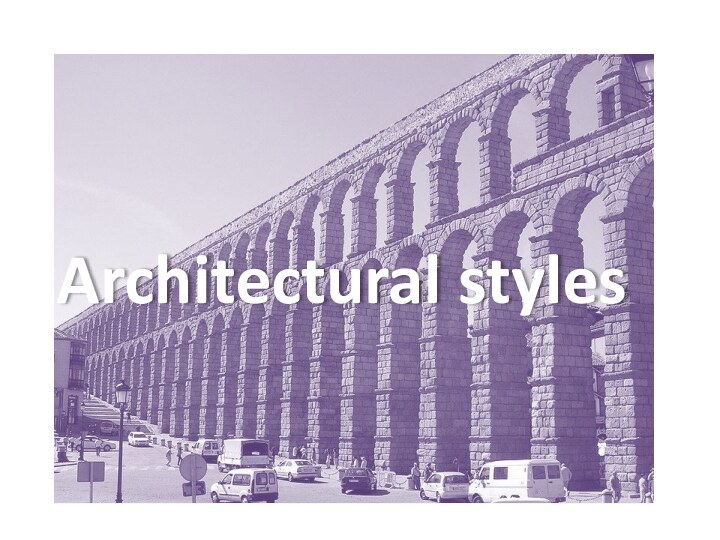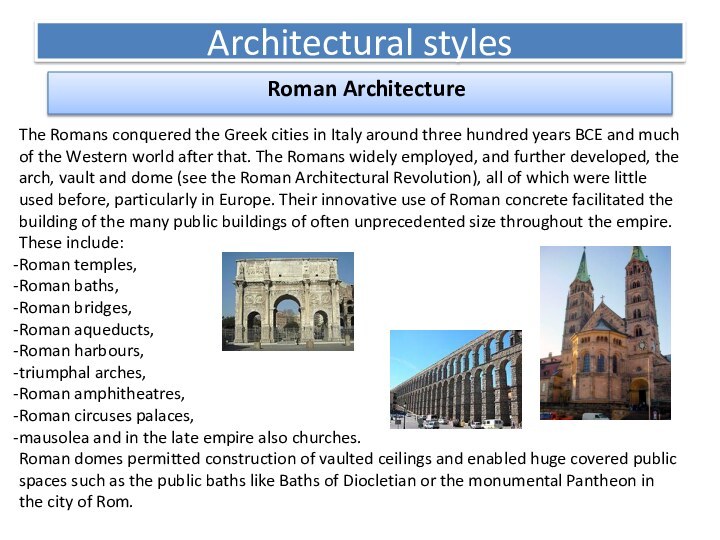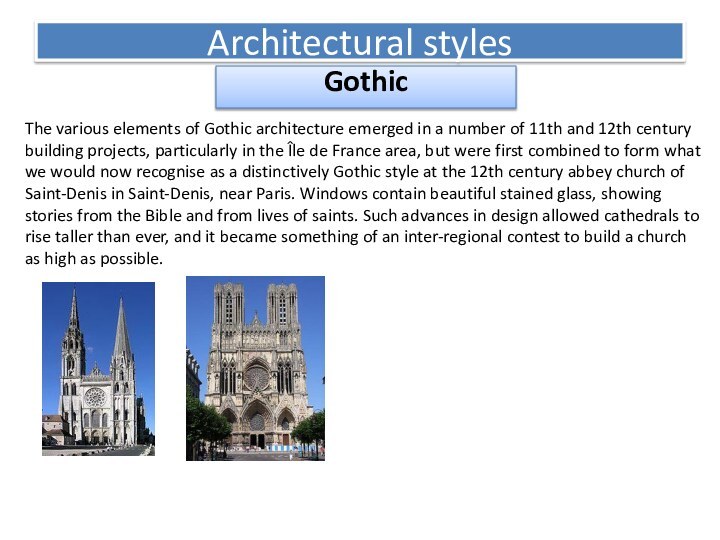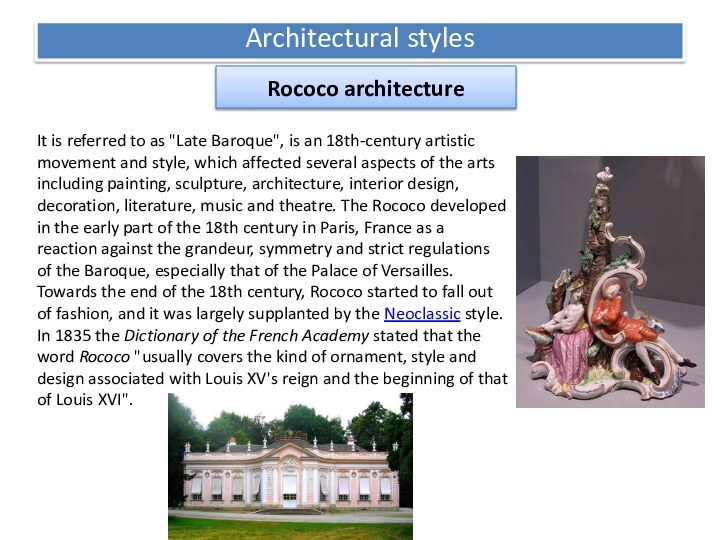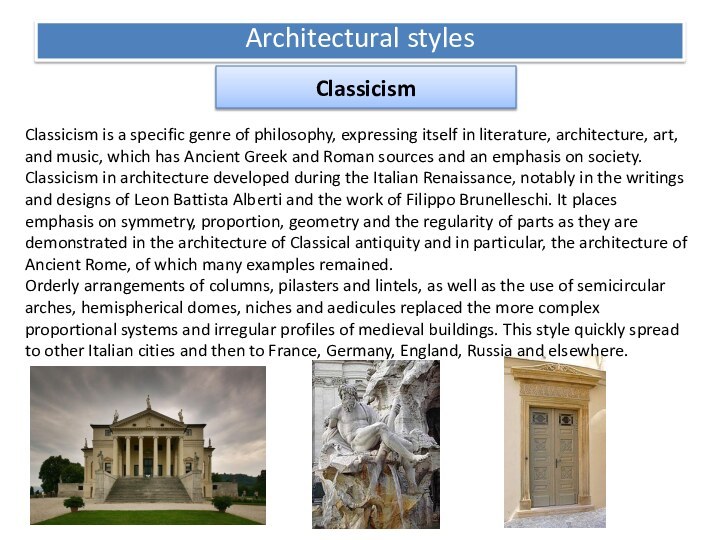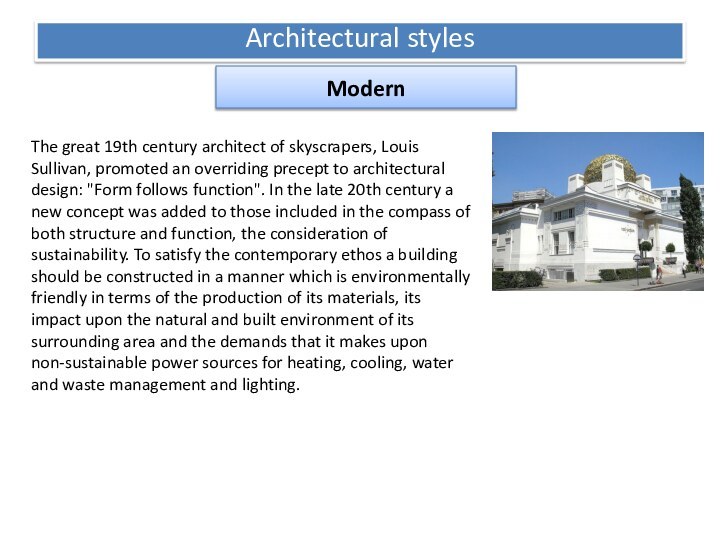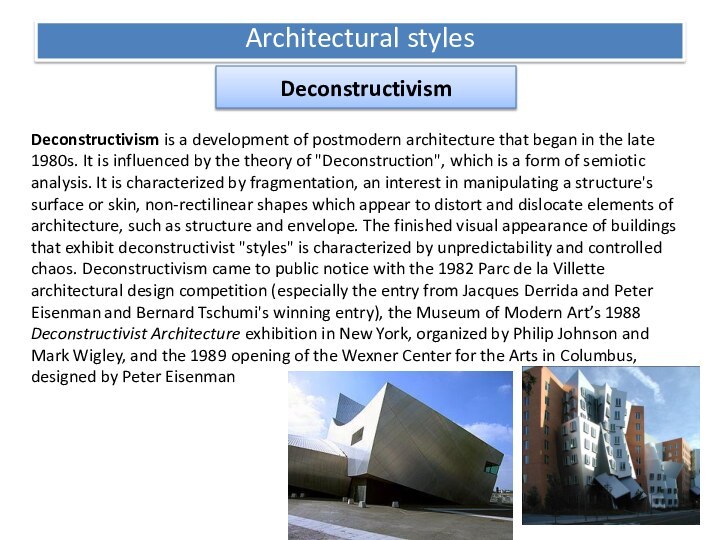Слайд 2
Architectural styles
Roman Architecture
The Romans conquered the Greek
cities in Italy around three hundred years BCE and
much of the Western world after that. The Romans widely employed, and further developed, the arch, vault and dome (see the Roman Architectural Revolution), all of which were little used before, particularly in Europe. Their innovative use of Roman concrete facilitated the building of the many public buildings of often unprecedented size throughout the empire. These include:
Roman temples,
Roman baths,
Roman bridges,
Roman aqueducts,
Roman harbours,
triumphal arches,
Roman amphitheatres,
Roman circuses palaces,
mausolea and in the late empire also churches.
Roman domes permitted construction of vaulted ceilings and enabled huge covered public spaces such as the public baths like Baths of Diocletian or the monumental Pantheon in the city of Rom.
Слайд 3
Gothic
Architectural styles
The various elements of Gothic architecture emerged
in a number of 11th and 12th century building
projects, particularly in the Île de France area, but were first combined to form what we would now recognise as a distinctively Gothic style at the 12th century abbey church of Saint-Denis in Saint-Denis, near Paris. Windows contain beautiful stained glass, showing stories from the Bible and from lives of saints. Such advances in design allowed cathedrals to rise taller than ever, and it became something of an inter-regional contest to build a church as high as possible.
Слайд 4
Renaissance architecture
Architectural styles
It is the architecture of the
period between the early 15th and early 17th centuries
in different regions of Europe, demonstrating a conscious revival and development of certain elements of ancient Greek and Roman thought and material culture. Stylistically, Renaissance architecture followed Gothic architecture and was succeeded by Baroque architecture. Renaissance style places emphasis on symmetry, proportion, geometry and the regularity of parts as they are demonstrated in the architecture of classical antiquity and in particular ancient Roman architecture, of which many examples remained. Orderly arrangements of columns, pilasters and lintels, as well as the use of semicircular arches, hemispherical domes, niches and aedicule's replaced the more complex proportional systems and irregular profiles of medieval buildings.
Слайд 5
Baroque architecture
Architectural styles
It is the building style of
the Baroque era, begun in late 16th century Italy,
that took the Roman vocabulary of Renaissance architecture and used it in a new rhetorical and theatrical fashion, often to express the triumph of the Catholic Church and the absolutist state. It was characterized by new explorations of form, light and shadow and dramatic intensity.
The periods of Mannerism and the Baroque that followed the Renaissance signaled an increasing anxiety over meaning and representation. Important developments in science and philosophy had separated mathematical representations of reality from the rest of culture, fundamentally changing the way humans related to their world through architecture. It would reach its most extreme and embellished development under the decorative tastes of Rococo.
Слайд 6
Rococo architecture
Architectural styles
It is referred to as "Late
Baroque", is an 18th-century artistic movement and style, which
affected several aspects of the arts including painting, sculpture, architecture, interior design, decoration, literature, music and theatre. The Rococo developed in the early part of the 18th century in Paris, France as a reaction against the grandeur, symmetry and strict regulations of the Baroque, especially that of the Palace of Versailles. Towards the end of the 18th century, Rococo started to fall out of fashion, and it was largely supplanted by the Neoclassic style. In 1835 the Dictionary of the French Academy stated that the word Rococo "usually covers the kind of ornament, style and design associated with Louis XV's reign and the beginning of that of Louis XVI".
Слайд 7
Classicism
Architectural styles
Classicism is a specific genre of philosophy,
expressing itself in literature, architecture, art, and music, which
has Ancient Greek and Roman sources and an emphasis on society. Classicism in architecture developed during the Italian Renaissance, notably in the writings and designs of Leon Battista Alberti and the work of Filippo Brunelleschi. It places emphasis on symmetry, proportion, geometry and the regularity of parts as they are demonstrated in the architecture of Classical antiquity and in particular, the architecture of Ancient Rome, of which many examples remained.
Orderly arrangements of columns, pilasters and lintels, as well as the use of semicircular arches, hemispherical domes, niches and aedicules replaced the more complex proportional systems and irregular profiles of medieval buildings. This style quickly spread to other Italian cities and then to France, Germany, England, Russia and elsewhere.
Слайд 8
Eclecticism
Architectural styles
It is an eighteenth- and nineteenth-century architectural

style in which a single piece of work incorporates
a mixture of elements from previous historical styles to create something that is new and original. In Architecture and Interior Design, these elements may include structural features, furniture, decorative motives, distinct historical ornament, traditional cultural motifs or styles from other countries, with the mixture usually chosen based on its suitability to the project and overall aesthetic value. Eclecticism came into practice during the late 18th century, as architects sought after a style that would allow them to retain previous historic precedent, but create unseen designs. From a complete catalogue of past styles, the ability to mix and combine styles allowed for more expressive freedom and provided an endless source of inspiration. Whilst other design professionals (referred to as ‘revivalists’) aimed to meticulously imitate past styles, Eclecticism differed, as the main driving force was creation, not nostalgia and there was a desire for the designs to be original.
Слайд 9
Modern
Architectural styles
The great 19th century architect of skyscrapers,
Louis Sullivan, promoted an overriding precept to architectural design:
"Form follows function". In the late 20th century a new concept was added to those included in the compass of both structure and function, the consideration of sustainability. To satisfy the contemporary ethos a building should be constructed in a manner which is environmentally friendly in terms of the production of its materials, its impact upon the natural and built environment of its surrounding area and the demands that it makes upon non-sustainable power sources for heating, cooling, water and waste management and lighting.
Слайд 10
Modern in architecture
Architectural styles
Modern architecture is generally characterized
by simplification of form and an absence of applied
decoration. It is a term applied to an overarching movement, with its exact definition and scope varying widely. In a broader sense, early modern architecture began at the turn of the 20th century with efforts to reconcile the principles underlying architectural design with rapid technological advancement and the modernization of society. It would take the form of numerous movements, schools of design, and architectural styles, some in tension with one another, and often equally defying such classification.
Слайд 11
Constructivism
Architectural styles
Constructivist architecture was a form of modern

architecture that flourished in the Soviet Union in the
1920s and early 1930s. It combined advanced technology and engineering with an avowedly Communist social purpose. Constructivist architecture emerged from the wider constructivist art movement, which grew out of Russian Futurism. Constructivist art had attempted to apply a three-dimensional cubist vision to wholly abstract non-objective 'constructions' with a kinetic element. After the Russian Revolution of 1917 it turned its attentions to the new social demands and industrial tasks required of the new regime. The first and most famous Constructivist architectural project was the 1919 proposal for the headquarters of the Committer in St Petersburg by the Futurist Vladimir Tatlin, often called Tatlin's Tower. Though it remained unbuilt, the materials—glass and steel—and its futuristic ethos and political slant (the movements of its internal volumes were meant to symbolize revolution and the dialectic) set the tone for the projects of the 1920s
Слайд 12
High-tech
Architectural styles
High-tech architecture, also known as Late Modernism
or Structural Expressionism, is an architectural style that emerged
in the 1970s, incorporating elements of high-tech industry and technology into building design. High-tech architecture appeared as a revamped modernism, an extension of those previous ideas helped by even more technological advances. This category serves as a bridge between modernism and post-modernism, however there remain gray areas as to where one category ends and the other begins. Buildings in this architectural style were constructed mainly in North America and Europe. It is deeply connected with what is called the Second School of Chicago which emerged after World War II. The main content is that the technological kind of construction, mostly with steel and glass, is expressed in a formal independent way to gain own aesthetic qualities out of it
